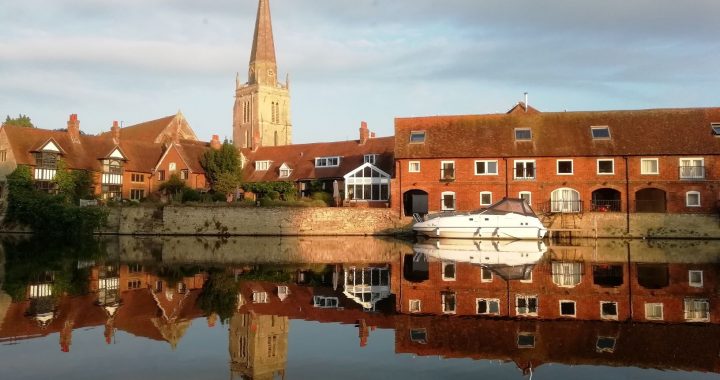Thursday’s assault on Thames & Kennet Marina in Reading, from our forward lying up position at Sonning Lock, was as straightforward as we had planned; roughly 2 miles travelled and we had located our berth, moved onto it and tied up in a little over an hour. A lovely, sunny morning to be on the move with no wind to complicate things as we manoeuvred around the marina basin. There is an awful lot of water around this area with the Redgrave-Pinsent Rowing Lake and Caversham Lakes just beside the marina, so much water, in fact, that when I asked at the office for directions to the road they asked me if I realised it was about a mile and a half from there! The approach snakes around a series of detours to work around various lakes and lagoons to get to their site.
Today we were going up to Long Itchington so that we could go and see our house for the first time tomorrow. This time everything worked according to plan with the only exception being the laundry service we had booked to pick up the heavy washing at 12:00. We got a call at 10:00 to say they were looking for our boat in the marina, obviously this was a problem as we weren’t there yet. In the end we had to drop it off in the taxi on the way to the station and it was far from being on the way. Reading seems to be a big place and about as we expected, having driven round most of it because of this mix-up. The taxi driver assured me that it wasn’t as big as it seemed, it was just that the roads and the one-way systems made it seem very big. This was an interesting perspective but perception and the taxi meter are king and the fare certainly suggested we had travelled a long way.
White Hall Farm in Long Itchington dates from the 1400’s, with many alteration and additions over the centuries. It has many original features, large well-proportioned rooms and is beautifully dressed and decorated in keeping. Having just started to offer B&B on two of the ’empty nest’ rooms in the last year or so it is already getting very good reviews and I guess this is another. We received a warm welcome, had a really comfortable stay, an excellent breakfast and were given free rein to use a large sitting room just down the landing rather than just lurk in our bedroom. If you are looking for somewhere to stay in the village this is the best option there is.
We had hoped to validate our positive view of The Harvester as the place to dine in Long Itchington but here we were in for a disappointment. The chef was on holiday, only returning the next day and the only food on offer was from the wood-fired pizza oven at the top of the garden. We had heard the output from there is excellent but it wasn’t what we had built our expectations on tonight, so we finished our drinks and moved on to The Duck On The Pond. That’s the thing about a night out in ‘Long Itch’ – plenty of options. We don’t think it is time to mark The Harvester down just yet, we will reserve judgement until next time and hope to consolidate our view that it has the best food in town then.
Friday morning was perfect. Fresh air, warm sun, blue skies, dew on the grass. An ideal day to view our new home. It does exist! There are walls, a roof, windows etc and you can see the whole shape of it. We were able to check off the options we had had to choose, put in a change request on the bathroom mirror and we also got a chance to see the inside of an identical house that is much more finished with a lot of the decoration completed. When you go into a building that is just past first Fix and the walls are plasterboard, cables are running everywhere, the floors are bare and it is full of trades going about their business (mainly drinking coffee) the space always seems small and cramped. Being able to also see a more finished product was great reassurance that, by the time we move in, the space will feel much lighter and more open. The light in the garden and the movement of the sun seems to work just as we hoped and the visit was very positive by the end.
Sue had been able to measure the windows for future curtain / blind options. I had been able to establish where the steel in the lintels would be so I could advise her what fixings not to consider. That left a short trip into Southam and the eponymous Southam Carpets to choose the soft flooring pattern and arrange for them to measure up and order in the material. When will all this happen? At the moment we seem to back to saying 31st October. They are well ahead to meet that date so it shouldn’t be later. We could push for them to finish earlier but we aren’t in a hurry and pushing people to do things quicker doesn’t usually produce a higher quality outcome.
The return trip to the marina went smoothly again, a couple more points in the positive column for public transport, I suppose. We made it back for about 16:00 and as we didn’t want to pay for another night there we were now in a bit of a hurry. We had to clear the rubbish, fill up with water and get across to their service dock to settle up and book out before they closed at 17:00. As we would be on their fuel dock anyway I had planned to top up the diesel tank. Being self-service and in a bit of a rush I just got on with it and went in to pay. This where I realised that too much haste had made me forget one of Neil Payne’s key pieces of advice – “always check the split before you fill up”. We usually declare 80% domestic and 20% propulsion. Domestic usage enjoys tax relief that makes quite a difference to the cost. To my horror in this place they insisted they would only use a standard 40% domestic and 60% propulsion split. Since the fuel was already in the tank I was hardly on the front foot to argue this one and just had to pay up. The worst of this I didn’t realise until the next day when I did the sums. It looks to me as if they charged the entire quantity at £1.34 anyway. If so the split is irrelevant to me and they have, presumably, just pocketed the 15% VAT saving on 40% of it. A good job I was just topping up the tank while I was there and didn’t have to fill up from empty at 250 litres!
By now it was 17:30 and we still had to do the shopping. There is a Tesco Extra just beyond the marina entrance and mooring right beside it. We had thought this was restricted to 2 hours but there were no notices on display about any restrictions at all when we arrived at the rather smart new landing. It was also empty except for two very down at heel and overladen plastic boats at the far end. We moved up close to them, already thinking that if we moored now, left plenty of space for others and moved on early the next morning we might get away with staying here overnight. That would save us hunting for space at seven or eight o’clock at night in unfamiliar territory. Looking around a bit further I did find a notice lying in some fallen leaves that suggested you had to register arrival and pay £9.50 for every 24 hours to moor here. We decided not to bother and were pretty sure our neighbours would not have paid for the privilege. That didn’t stop us feeling guilty, of course. Neither of us are usually comfortable flouting the rules.
We have noticed a lot more instances of people camping alongside the river at this end. Quite often when we have moored in the last few days, thinking the area deserted, you only had to peer through the surrounding tree line to spy little pop-up dome tents lurking in the undergrowth camouflaged against the bushes. As you travel along, if you start to look, you can see more small encampments hidden away, just beyond the banks. Generally, you don’t see anyone there. They don’t make much noise, move quietly in or out and seem to spend their time at the tent, inside the tent. Once or twice, standing outside late at night in the still air, I have heard voices murmuring and realised the occupants had returned unseen but that is about it. Here at Reading, however, we looked around and could just see 3 or 4 people gathered around a proper camp fire that had obviously been going most of the day. As the evening wore on the talk got louder, occasional shouts were heard as their conversation reached a point of real disagreement, followed by the opening of another tin and a heart-warming moment of reconciliation (“we’ve all had a drink . . . “) before the next outburst. All this set to music coming from an ancient boom box and playing just loud enough to be heard. These guys must all have been in their fifties and it created a scene that made one think of novels of people movements during the great depression etc. As far as we could tell this little band were the crew of the boats that had been moored at the end when we arrived and it seemed they met regularly and knew one another well. Overall, apart from providing some diversion, they didn’t bother us. They were fairly easy to block out and as far as I could tell they actually packed up and crept off to bed surprisingly early at about 23:00.
Saturday morning, 1st September, officially the first day of autumn. A sunny morning, after a slightly colder night, had left just a suggestion of mist, like smoke on the water (but a lighter purple J ). We have been noticing the tree foliage turning brown over recent weeks and this morning the roof of the boat was covered in dried up, brown leaves. We’re pretty sure this had nothing to do with a dramatic effect of the overnight change in season but was a consequence of the lack of water through such a dry summer, which seems to have done quite a lot of damage to the trees.
Breakfast was accompanied by the sound of one of our neighbours trying to start the outboard engine on his floating scrapheap. Each pull and cough of the starter handle was another ratchet in the tension. The engine would catch and fire, lifting our spirits only to have them dashed again as it spluttered and died. Once or twice it really seemed to have got running but when left unattended, presumably to cast off, it would sulk and fall silent. In the end the captain, whose enthusiasm for the task never seemed to flag adopted what might be regarded as a high risk approach. He cast off the boat and shoved off away from the bank into the river with no motive power at all. Then sitting, adrift, in the middle of the Thames he turned his attention once more to the pull cord. After a few tries the engine caught and fired as it had before but this time, as he was able to keep a firm and experienced hand on the throttle he managed to keep it going, engaged the prop and headed nonchalantly away towards the rising sun accompanied by our cheers and applause.
It was a perfect day to be travelling on the water the air was fresh and clean but the sun was hot and it strengthened to become one of the warmest days we have had for a couple of weeks. As it we had left early, to make good our escape from the mooring police, the locks were on self-service but it turned out to be extremely easy to operate them. This might seem to make the role of the lockkeeper redundant but it is an essential one although it is not the locks they need to manage but the people in them. With one or two boats going through on their own it is fine. When it gets busy the real skill is in controlling who comes in, when, on which side and ensuring they have all got themselves secured against the currents before the sluices open. I can’t begin to imagine the chaos and eventual antagonism that would develop if six or eight boats together were left to their own devices to negotiate these locks.
Seen from the water, Reading (they would probably prefer to call it Caversham) doesn’t seem nearly as bad as you might expect. They have a couple of nice bridges, plenty of open park space on the riverside and a lot of boating activity. As you go beyond the town there are miles of hoarding on the south side and we couldn’t work out what was behind them at all. On the opposite bank was a similar expanse of open field all marked out with signs like: “Road W23”. This too seemed to go on forever. There seemed to be piles of accumulated rubbish gathered together as if awaiting collection. It seemed as though it must be some kind of permanent showground or exhibition site, although we believe the Reading Festival was held elsewhere. Google was uninformative on both counts so any suggestions or local knowledge would be welcome. Both features ended, eventually, as we came past Mapledurham, Purley On Thames (who knew!) and Whitchurch which is near Pangbourne. Once out of Reading there are lots of nice houses here too but while they are obviously expensive status symbols they somehow don’t seem quite as grand or extravagant as the displays on the way out of Henley.
We passed through the Goring Gap, where the Berkshire Downs and the Chiltern Hills meet and form the narrowest part of the Thames Valley, to arrive at Goring Lock moorings where we easily found a good space, free for 24 hours, on a well-constructed wharf and in time for lunch. We had thought of walking back to a National Trust property at Basildon Park but the contours of the Goring Gap and the position of the crossings made any route on foot far too long and convoluted. We settled for a circular walk from Goring across the bridge to Streatley sitting on the other side and up into an area called The Holies before circling back across Lardon Chase and back to the bridge. This route promised fabulous viewpoints from three positions to see right across Goring itself, then out over the Gap and the Chilterns and finally in the other direction west of the river and across the Berkshire Downs. It was not that long a walk. Unfortunately, the very contours that had frustrated our attempt to find a route to Basildon Park meant that each of these vantage points was preceded by extremely steep climbs and followed by equally sharp descents. It is always heart-breaking to see hard-won height so rapidly lost. Nonetheless, the views were every bit as stunning as billed and made the effort worthwhile. Only 6½ miles, so not too taxing in theory but with 3,000 feet of ascent on top of that we felt we had earned a drink at the Miller of Mansfield in Goring. This turned out to be a really nice pub offering an excellent table by the window, with a good view of the village, where you could sit and soak up the evening sun.
We had come to the view that, on the Thames, where the cruisers and gin palaces come out in their hundreds at the end of the week, we would be well advised to moor up on Friday night or Saturday morning and stay put until Monday. As we needed to be clear of the Thames by 6th September, when our one month licence was due to expire, we couldn’t really afford that luxury so, on Sunday morning we set off a bit later than usual heading, eventually, for Wallingford. It was another glorious day, even warmer than Saturday and we managed to hit the first two locks just as they were about to close. When you enter a lock, heading upstream, you are a long way below the level of the river beyond and have no idea what lies ahead. As we left the Goring Lock itself the gates opened to reveal a shoal of canoeists lurking in the pound waiting to go down. They were all dressed alike, four or five to a boat, so we assumed it was some sort of club expedition but they caused little trouble and we sailed on thinking no more of it. The second lock, Cleeve Lock had a water point tucked just at the end of the lock landing which we intended to use. The reach from Goring Lock to Cleeve Lock, at 1,100 yards is the shortest on the river so we were there almost immediately and went straight in to find a slightly harassed looking lockkeeper who told us: “I thought I was doing fine this morning then I suddenly had about 50 canoes turn up and now I’m just trying to get everyone through as quickly as possible.”
What we had encountered downstream was just the first batch. These gates opened to reveal twice the number of canoes, all with crews in the same yellow jerseys, milling about in the cut. Around them more conventional lock users had arrived and were trying to avoid them including blocking the water point. We threaded our way through and had no choice but to move over towards the weir race and wait patiently, backing and filling, while the situation sorted itself out. As far as we could tell they some sort of taster session with an experienced cox in each boat. They didn’t seem to be that competent and took an age to move into the lock.
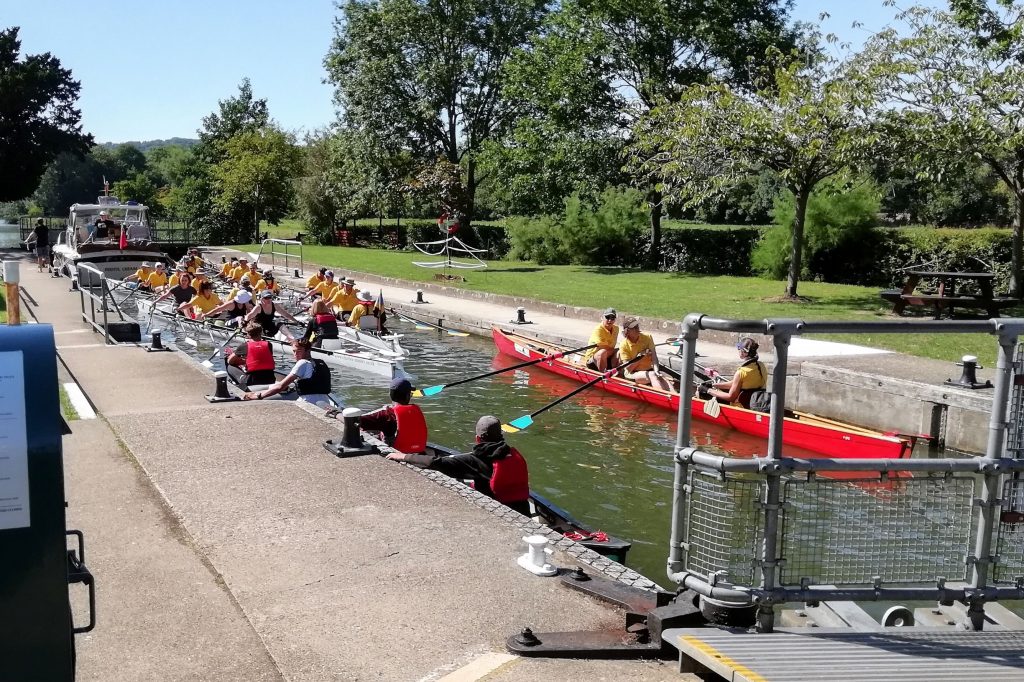
Shoal of canoes seizing the lock
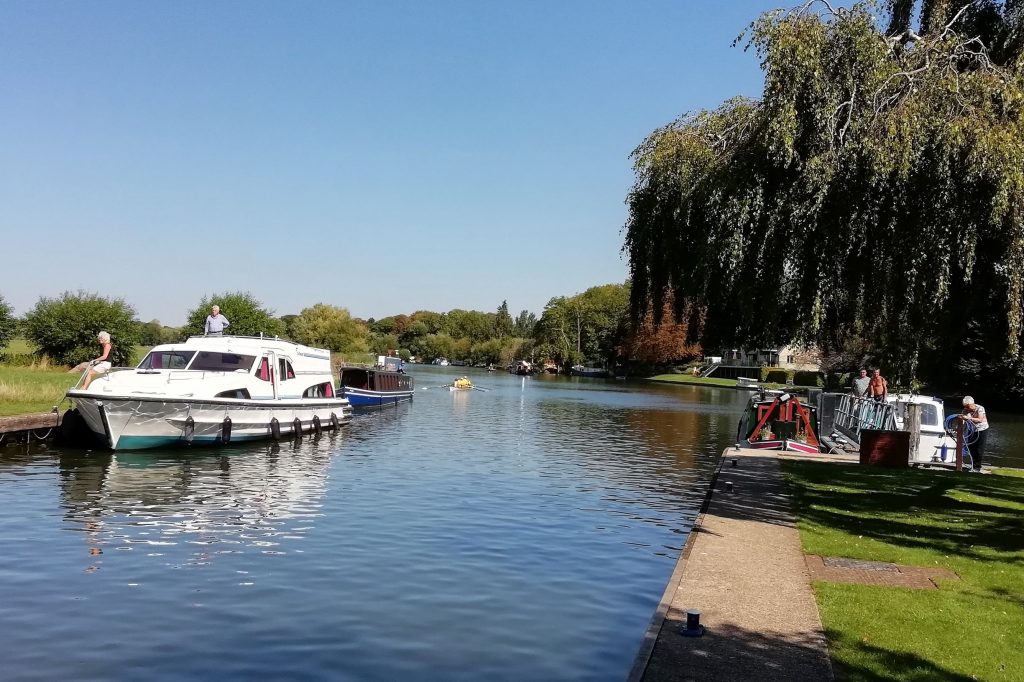
Queue created by the canoe jam
While we were waiting the boat on the water point moved out of the way and chatting to them we learned that there was something called “Bunkfest” being held at Wallingford all weekend with many boaters in attendance. The combination of that, weekend cruisers and brilliant sunshine made it likely that we wouldn’t find mooring in the town as we had hoped and that indeed proved to be the case. We found nowhere suitable, in places that would have been two or three boats were already breasted up and so we ended up at Benson Lock. Had a word with the lockkeeper about the mooring available at the lock and he was somewhat hesitant as to whether we could fit on the end of his lock mooring on the upstream side. As we were waiting for the lock to fill he came back and said he thought we would just fit and by the way, we had just pipped two other boats to the post by about three minutes. Clearly mooring genuinely was at a premium today.
After a late lunch, we wandered down to Wallingford via the scattered castle ruins. The castle was not that informative and much harder to understand than Berkhamsted. Wallingford is said to be where William the Conqueror (or William the Bastard as he was known to pals) finally crossed the Thames in the course of consolidating his victory, with the support of Wigod the local Lord of the Manor. It is clearly a strategic crossing point and a major castle was built there very early in the conquest on the site of the old wooden fortifications. On the way up from Goring, all along the banks we had seen the outlines of pillboxes and gun emplacements thrown up during the second world war. Clearly, the civil defence teams in the ’40s felt that Hitler’s staff might well aim to emulate William’s approach. You can see very clearly that the wide flat plains between the hills would provide excellent tank country, in the dry season at least.
We had a look round at the remains of “Bunkfest”. Mostly, the stalls and stands were packing up in the town centre but performers were still going strong in several of the pubs and the streets remained very busy. At its height it must have been manic and it was clearly a big deal for the town.
Having returned to the boat, while Sue prepared a meal and watched Countryfile, I decided to go and have a poke around Benson. It turns out that the town isn’t by the river at all. A busy A road cuts off a segment of land along the water behind which are a lot of very nice, large, secluded and expensive properties. To find the town you have to cross the main road and walk up to the church and the centre. It is pretty unremarkable. It is more of a village than a town, the church looks run down, one of the pubs is now a house and with the exception of the Co-op the shops in the High Street are typically useless ‘specialist’ places dealing with ‘upcycled’ furniture, ‘vintage’ clothing and the like. A true dormitory community.
At the top of the High Street I came to The Crown, which had a notice on the window proclaiming “New Management, New Chef, New atmosphere”. Presumably, the latter was code for new customers. It seemed rude not to try out this reincarnation if so much effort had gone into it so I stepped inside for a pint. I wasn’t that impressed, the advertised new ‘atmosphere’ was clearly a work in progress, possibly doomed never to be successful. The most remarkable feature was the pub lavatories. Clearly someone with influence had casually suggested adopting a brewery theme and the minions had taken the ball and rather let it run away with them. Only pictures can describe what I found there:
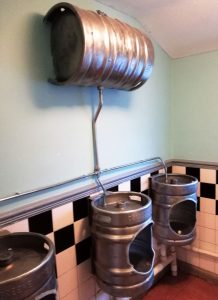
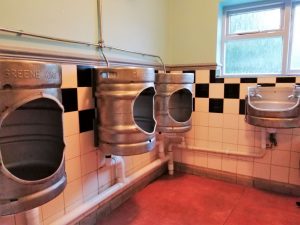
Over zealous adherence to the interior design brief
Monday morning dawned bright enough but chillier, with much less strength to the sun when it broke through. There was almost no traffic on the water in the morning. We had a few miles to go and our route to Oxford would take us into Clifton Hampden and through the Clifton Cut. This cuts off a meandering section of the river that is now navigable for only half its length and has a weir at the top. Nonetheless, the navigable section ends at The Plough in Long Wittenham and as there was mooring shown there we decided not to go through Clifton Lock today but to explore the disused arm and moor there overnight. We arrived at lunchtime just as a boat called “Bumble” was tying up. We had just room to turn and back the stern into the overhanging bushes to moor up behind “Bumble” on a plank and scaffolding wharf at the bottom of The Plough garden. It’s quite a long garden. It takes about 5 minutes uphill to get to the bar!

Where is the Pub?

I told you it would fit!
As it was already lunchtime we decided on a pub lunch with our light salad deferred to become an evening meal. Very good food, including home-made shortcrust pie with gravy that turned out to be mostly chicken, bacon & cider filling rather than mostly pastry. We definitely needed to work that off so took a walk back around the long curve of the Thames path to Day’s Lock, from the landward side this time and then straight across the arc over fields from Clifton Hampden back to Long Wittenham. Clifton Hampden, in particular, was a very well-kept hamlet with a lovely old church and manor house in good condition at its centre. At Day’s Lock we were in sight of Dorchester, where we know Jason Moore has family and we were tempted to go and have a look. In the end, the extra couple of miles for the return trip was a bit more than we wanted to do at that point, so we left it for another time.
Back at the boat there was a cruiser moored alongside with its crew drinking beer nearby. A number of vessels came up the arm, found no room at the Inn (literally), turned around and retreated back towards the junction. In the end, with the cruiser now departed, Sue took pity on one elderly couple in “Natterjack II” and invited them to moor alongside for the night.
Tuesday morning, once our neighbours had cleared away, we hauled ourselves out of the tree and the very shallow water before engaging the propeller and headed back, full steam, towards Clifton Hampden and Clifton Lock. I wasn’t really looking at the chart and somehow thought the turning for the lock was back by the bridge we could see in the distance when, in fact, it doubled back around the nose of an island well before that. We hadn’t attempted a handbrake turn in a narrowboat before, she took it pretty well and we completed a 340° turn, at speed, very smoothly. Clearly one of the benefits of the river; it could have been a real issue on a much narrower canal.
We were heading for Abingdon, somehow not expecting very much. Neither of us can quite put our finger on what association with the name had left us both with such a negative view but it was clearly a false perception. Abingdon was far more attractive than we had anticipated and also far more welcoming to boaters than almost anywhere we had so far visited on the Thames. Plenty of mooring was available, free for up to 3 days stay, alongside well maintained siding and beautifully kept parks a stone’s throw from the bridge and main route into the town. There were rings to tie up to and clean, clear notices explaining the terms and locations of visitor mooring versus that available to residents of White Horse Vale by permit only. What we saw as we walked up to Tesco, a mile or two away, along the Ock River Trail looked interesting and seemed to be well documented in signs and information boards along the way. We were now somewhat under pressure to move on and get off the river, with our licence expiring the next day. Otherwise we might well have stayed another day in Abingdon and explored it further. As it was we have made a note to return on another trip and get to know it better.
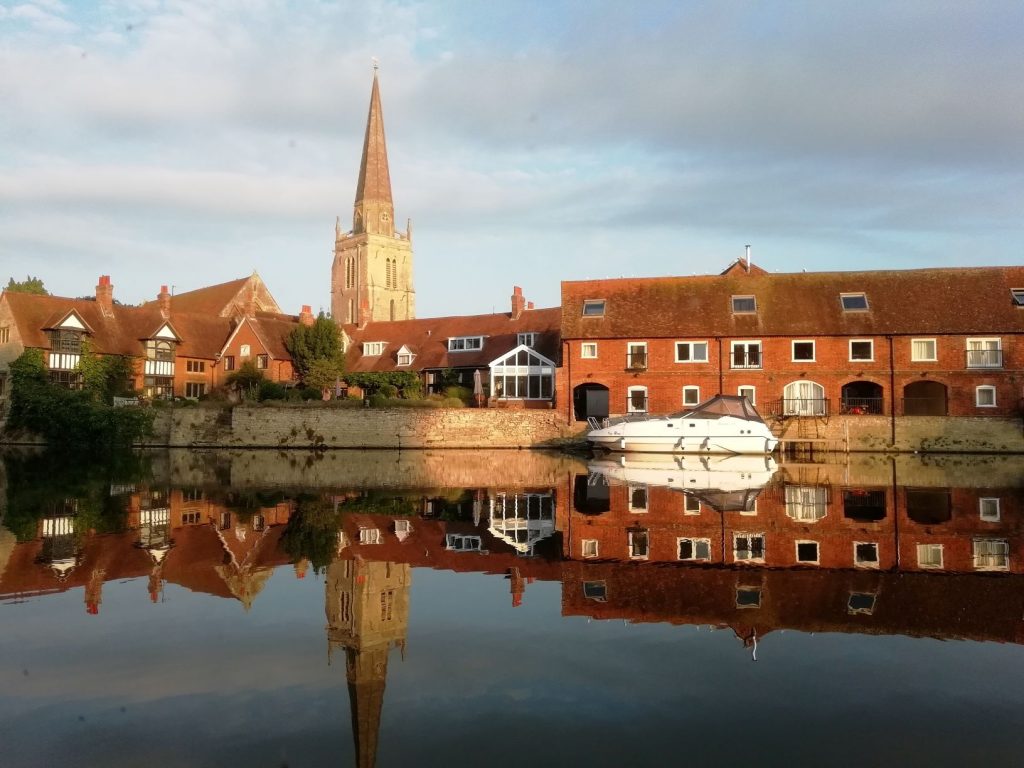
St. Helen’s Church Abingdon on a lovely autumn morning
Moored under the shadow of the church spire, with The Nag’s Head overlooking us from the bridge, we had to go and sample the latter. Not a bad pub, quite a nice position, shame about the self-absorbed and indifferent staff. Still it was a nice place to sit and have a drink at the end of the day. We returned to the boat to the sound of the bells of St. Helen’s as Abingdon’s campanologists warmed up for an evening’s practice. Apparently, Abingdon has a very fine and extensive array of bells that have to be exercised regularly and the ringers meet every Tuesday evening from seven until nine. Not only were we only a few yards away but on alternate Tuesdays they practice at St. Nicolas’ on the other side of town instead, so our luck was in! Eventually one of the regular silences between peals extended to a point where we realised it wasn’t going to start again this time and it was all over. We could now settle down to a peaceful evening. At least we hadn’t arrived on a Friday when the learners’ practices take place.
The next day, Wednesday 5th September, was the day our licence for the Thames ran out at midnight. Another fine, dry, bright, sunny morning. Fresh at the start but warming up more quickly than on Tuesday. We felt we should probably try not to get used to this weather; it has to break properly sometime. We planned to moor up near to Oxford that night and then run through and get well out into the Oxford Canal and away from the city outskirts by the next evening. We would be relying on a degree of discretion from the EA through the last couple of locks as we would technically have overstayed. Straightforward run up to the outskirts of Oxford through three locks, including Sandford. Here we found the same lockkeeper we had talked with at Benson who told us what was different about Sandford Lock, apart from the fact that you could see it was even bigger than others we had encountered, at least half as wide again. Apparently, it also has the deepest drop on the non-tidal Thames and to manage the turbulence created in that volume of water, the lock fills from the bottom. The sluices open through pipes sitting on the bottom which then release it evenly to raise the lock level.
There is a lot of bank available for mooring on the approach to Oxford and we were aiming for an area just south of Folly Bridge and opposite Christchurch Meadow. Unfortunately, the welcoming approach of Abingdon is not replicated here. It isn’t hostile, just indifferent. There are no rings or bollards to tie up to, the metalled path runs very close to the bank so it is hard to get a secure purchase for your pins, the banks are high and variably overgrown and where shoaling or a shelf underwater prevents you reaching the bank it isn’t apparent or signposted so it is a matter of trial and error. We thought we had found a spot next to “Sans Souci” who had passed us over lunch. In fact there was an obstruction so that wouldn’t worked. We turned around, so easy on the Thames and found a spot downstream that was not ideal. We had not quite finished tying up when “Sans Souci” sailed past. After a brief debate we decided to turn again and move back up to the spot where they had been moored before. It was still vacant and we did get in although it was hardly simple. In the end we had spent 1 hour 10 minutes on the mooring process and we had to conclude that, this had been the most awkward site we had encountered on our whole month on the Thames. On the positive side, nobody was demanding any fees for mooring there.

